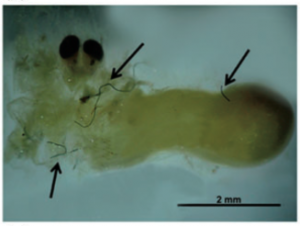Plastic debris contamination in the Acoupa weakfish (Cynoscion acoupa) in a tropical estuary
By Elana Rusnak, SRC intern
The Acoupa weakfish (Cynoscion acoupa) is an economically important fish that lives along the tropical east coast of the American continents. They tend to live in estuary systems—calm, brackish water habitats—as juveniles and sub-adults, and then move to saltier areas as they age. Tropical estuaries are one of the most productive ecosystems on Earth, and they provide shelter, food, and developmental grounds for many species of fishes and invertebrates. Unfortunately, since estuaries are more sheltered environments, plastic debris tends to accumulate and be ingested by the many species that make the estuary their home. A study by Ferreira et al. in 2016 explored the feeding habits of all life stages of the Acoupa weakfish in the Goiana Estuary in Brazil, and described the plastic debris contamination of the area and how it affects these economically important fish.
In this study, the fish were subdivided into three study groups: juvenile, sub-adult, and adult. They were observed and captured in the upper, middle, and lower parts of the Goiana Estuary, with the lower part being the saltiest. About 470 juveniles, 25 sub-adults, and 33 adults were used in this study. The stomach contents of each fish were removed and examined to determine the ratio of plastic debris to their natural diet (fish, crustaceans, worms, seaweed, plant fragments). The researchers found that in almost every fish, the majority of the stomach contents consisted of plastic debris, followed by crustaceans and fish (64.4% of juveniles, 50% of sub-adults, and 100% of adults were contaminated with plastic). Multicolored plastics were also found in the digestive tract, and a few specimens had nothing in the stomach other than plastic debris.

Plastic debris inside a penaeid shrimp, a primary food source for adult Acoupa weakfish (Ferreira et al., 2016)

Zoomed in image of red plastic debris inside the digestive tract of an Acoupa weakfish specimen (Ferreira et al., 2016)
So what does this all mean?
First, the Goiana Estuary waters are polluted with plastic debris at densities comparable to half the density of the fish larvae that reside in it (Lima et al., 2015). This indicates that this estuary system is very polluted. Moreover, the Acoupa weakfish isn’t the only organism ingesting all this plastic. The direct ingestion of plastic debris might primarily occur during the early stages of the Acoupa weakfish, whereas sub-adults and adults ingest debris through the trophic food chain (their prey ingests the plastic, then it is left behind in the adult fish’s stomach). This occurs through a process called biotransferrence. The presence of plastic in the digestive system is also problematic, as it can lead to digestive injuries and induce starvation. Since the Acoupa weakfish is a top predator in their estuarine habitat, they are more susceptible to food web disturbances.
This fish is not only a primary food source for the locals in the area, but it is also commercially fished. If they are filled with plastic, they are not getting the nutrition they need to become large, healthy fish. Without this growth, both the locals and the commercial industry will suffer. This study really showed the large-scale change that needs to begin now with regards to reducing plastic waste and keeping our environment clean and healthy.
Works cited
Ferreira, G.V.B., Barletta, M., Lima, A.R.A., Dantas, D.V., Justino, A.D.S., Costa, M.F. 2016. Plastic debris contamination in the ife cycle of Acoupa weakfish (Cynoscion acoupa) in a tropical estuary. ICES Journal of Marine Science 73: 2695-2707.
Lima, A. R. A., Barletta, M., and Costa, M. F. 2015. Seasonal distribu- tion and interactions between plankton and microplastics in a tropical estuary. Estuarine, Coastal and Shelf Science, 161: 93–107.




Leave a Reply
Want to join the discussion?Feel free to contribute!